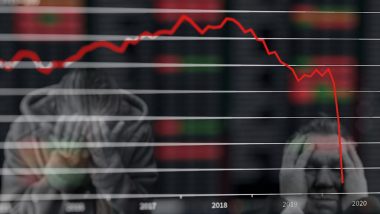New Delhi, July 26: After a 3.3 per cent contraction in 2020 and a 5.8 per cent rebound in 2021, global GDP growth is projected to slow to 2.7 per cent in 2022 and 2.6 per cent in 2023, said global financial services provider S&P Global Market Intelligence.
This forecast is attributable to the US economy's weaker first-half performance, while the 2023 downgrade reflects the widespread impacts of more restrictive financial conditions.
"With the world's population growing about 1.0 per cent annually, our outlook implies solid gains in real per capita GDP and thus avoidance of a global recession," said Sara Johnson, Executive Director, Economic Research, S&P Global Market Intelligence. President Biden Says US Not Going to Be in Recession.
The risk of recession remains high in the 40-50 per cent range in major economies. Global GDP has likely declined in the second quarter of 2022, but this expected outcome is not inevitably the beginning of a global recession.
"A period of subpar global growth is the most likely outcome. Absent of new shocks, the global economy is projected to resume growth, albeit at a tepid annual pace of under 2.0 per cent quarter-quarter in the third and fourth quarters of 2022," Johnson said. Mainland China is reopening after lockdowns and Asia Pacific's emerging markets are achieving solid growth even as European and US economies struggle.
"Worldwide, the transition from pandemic to endemic for COVID-19 is enabling growth in travel, tourism, and other consumer service sectors that were hit hard during the 2020 recession. In advanced countries, household finances are generally in good shape, thanks to accumulated savings and asset appreciation in 2020-21. In a cycle dominated by consumer spending, households are positioned to drive the global expansion forward," Johnson added.
In response to the persistently high inflation rate and inflationary expectations, several central banks have been accelerating monetary policy tightening measures.
Further, investors lying out to safe haven countries would likely mean continued strength in the US dollar and elevated risks for emerging markets that depend on capital inflows to finance their trade and fiscal deficits.
In line with the evidence of declining prices of finished goods and becoming more pervasive in the final quarter of 2022, global inflation is projected to ease from 7.3 per cent in 2022 to 4.2 per cent in 2023 and 2.7 per cent in 2024, it said. Recession Risk Looms on Some Asian Economies, Sri Lanka's Downturn Likely in 2023: Survey.
Resilient growth in the Asia Pacific region is key to the outlook of sustained global economic growth in 2022 and 2023. This region will likely account for 53 per cent of global real GDP growth in 2022 and an exceptional 62 per cent in 2023. India, Indonesia, Vietnam, and the Philippines will likely achieve growth rates of 5-7 per cent.
"This performance reflects strong intra-regional growth dynamics related to regional free-trade agreements, efficient supply chains, competitive costs, and steady inflows of foreign direct investment. The region is also benefiting from strong pent-up demand for semiconductors and autos. Parts of the region experienced later waves of Covid-19 and are now experiencing robust recoveries following the easing of pandemic restrictions," it added.
(The above story is verified and authored by ANI staff, ANI is South Asia's leading multimedia news agency with over 100 bureaus in India, South Asia and across the globe. ANI brings the latest news on Politics and Current Affairs in India & around the World, Sports, Health, Fitness, Entertainment, & News. The views appearing in the above post do not reflect the opinions of LatestLY)













 Quickly
Quickly


